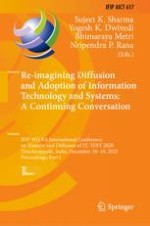This two-volume set of IFIP AICT 617 and 618 constitutes the refereed proceedings of the IFIP WG 8.6 International Working Conference "Re-imagining Diffusion and Adoption of Information Technology and Systems: A Continuing Conversation" on Transfer and Diffusion of IT, TDIT 2020, held in Tiruchirappalli, India, in December 2020.
The 86 revised full papers and 36 short papers presented were carefully reviewed and selected from 224 submissions. The papers focus on the re-imagination of diffusion and adoption of emerging technologies. They are organized in the following parts:
Part I: artificial intelligence and autonomous systems; big data and analytics; blockchain; diffusion and adoption technology; emerging technologies in e-Governance; emerging technologies in consumer decision making and choice; fin-tech applications; healthcare information technology; and Internet of Things
Part II: information technology and disaster management; adoption of mobile and platform-based applications; smart cities and digital government; social media; and diffusion of information technology and systems
